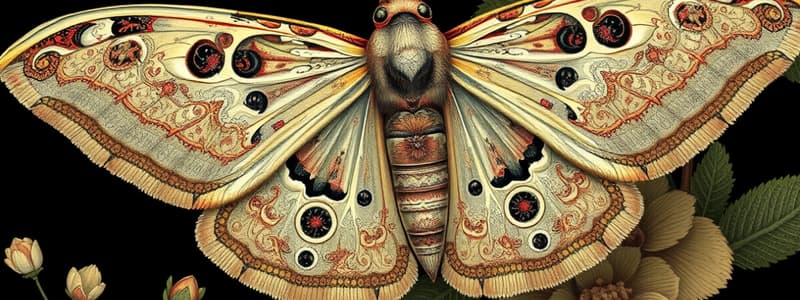Podcast
Questions and Answers
Where do peppered moths live?
Where do peppered moths live?
England, Europe, and North America.
How do the moth larvae survive predators?
How do the moth larvae survive predators?
Having a body that looks like a stick helps the larvae hide from predators.
What do the moths do during the winter?
What do the moths do during the winter?
They change into pupae.
What color is the 'typica' version of the moths?
What color is the 'typica' version of the moths?
What color is the 'carbonaria' version?
What color is the 'carbonaria' version?
How do adult moths survive predation?
How do adult moths survive predation?
What was the industrial revolution?
What was the industrial revolution?
What was causing the change in the color of the moths?
What was causing the change in the color of the moths?
Why would dark moths have an advantage?
Why would dark moths have an advantage?
What is an entomologist?
What is an entomologist?
How do scientists test theories?
How do scientists test theories?
Dr. Kettlewell predicted that clean forests would have light colored moths, and polluted forests would have dark colored moths.
Dr. Kettlewell predicted that clean forests would have light colored moths, and polluted forests would have dark colored moths.
How did Kettlewell test his hypothesis?
How did Kettlewell test his hypothesis?
How did Kettlewell determine if moths lived longer than others?
How did Kettlewell determine if moths lived longer than others?
Explain how the color of the moths increases or decreases their chances of survival.
Explain how the color of the moths increases or decreases their chances of survival.
Explain the concept of natural selection using your moths as an example.
Explain the concept of natural selection using your moths as an example.
Predict what would happen if there were no predators in the forest. Would the moth colors have changed? Why or why not?
Predict what would happen if there were no predators in the forest. Would the moth colors have changed? Why or why not?
If pollution near factories was reduced, what would happen to the color of the moths? Explain your answer.
If pollution near factories was reduced, what would happen to the color of the moths? Explain your answer.
Flashcards are hidden until you start studying
Study Notes
Peppered Moth Overview
- Peppered moths inhabit England, Europe, and North America.
- Moth larvae camouflage as sticks, helping them evade predators.
Moth Lifecycle
- During winter, peppered moths undergo a transformation into pupae.
Color Variations
- The typical (typica) peppered moth is light in color.
- The carbonaria version of the moth is dark or black.
Survival Strategies
- Adult moths avoid daytime predation and utilize nocturnal camouflage among trees.
Industrial Revolution Impact
- Factories in England burned coal, producing dark smoke that transformed the landscape.
- Light-colored trees covered in lichens became dark and bare, influencing moth survival.
Color and Survival Advantage
- Dark moths blend in with soot-covered trees, providing them a predation advantage.
Entomology
- Entomologists are professionals who study insects, either as a career or avocation.
Scientific Methodology
- Scientists formulate predictions based on theories and test them to compare observations against expectations.
Kettlewell's Hypothesis
- Dr. Kettlewell theorized that clean forests would host light moths, while polluted forests would favor dark moths.
Kettlewell's Experiment
- He conducted tests by placing light and dark moths on tree trunks, recording bird predation rates.
- Observations indicated that lighter moths were more frequently preyed upon on dark trunks.
Survival and Camouflage
- The likelihood of survival increases if a moth's color matches its environment, making it harder for predators to detect.
Natural Selection Concept
- Moths that matched tree colors had an advantage over differently colored counterparts, enhancing their survival.
Absence of Predators
- In predator-free forests, moth coloration would likely remain unchanged as camouflage would become irrelevant.
Pollution Reduction Effects
- If pollution diminishes, moth populations might still contain dark specimens, but a gradual shift to lighter colors could occur.
Studying That Suits You
Use AI to generate personalized quizzes and flashcards to suit your learning preferences.




